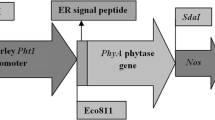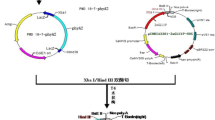Abstract
Using the cotyledon of white clover as explants, the transgenic white clover lines ectopic expression of the PhyA gene were established based on Agrobacterium tumefaciens-mediated transformation method. It was found that the tested transgenic lines were all Polymerase Chain Reaction (PCR) positive. The transgenic lines 1 to 4 were used for further Southern blot and Northern blot analysis. The lines 1 and 3 with higher level of PhyA expression were used to assay the phytase activities in root and its intercellular space. When the phytate was the sole phosphorus source, the phytase activities in root in lines 1 and 3 were 31.43% and 44.76% higher than those in control (CK), respectively. Meanwhile, the phytase activities in the root intercellular space in lines 1 and 3 were 3.3-fold and 5.12-fold higher than those in CK, respectively. The phosphorus concentration of plants, the accumulative P amount per plant, plant fresh weight, and plant dry weight were all much higher in lines 1 and 3 than in CK. Thus, it is clearly shown that ectopic expression of Aspergillus niger PhyA gene could significantly increase the ability for white clover to utilize organic phosphate under inorganic phosphate (Pi)-deficient condition.
Similar content being viewed by others
References
Ames P H (1966). Assay of inorganic phosphate, total phosphate and phosphatases. In: Neufeld E, Ginsburg V, eds. Methods in Enzymology. New York: Academic Press, 11–118
Brinch-Pedersen H, Sorensen L D, Holm P B (2002). Engineering crop plants: Getting a handle on phosphate. Trends Plant Sci, 7: 118–125
Chen M H, Huang L F, Li H M, Chen Y R, Yu S M (2004). Signal peptide-dependent targeting of a rice α-Amylase and Cargo proteins toplastids and extracellular compartments of plant cells. Plant Physiol, 135: 1367–1377
Dalal R C (1977). Soil organic phosphorus. Adv Agron, 29: 83–117
Denbow D M, Ravindran V, Kornegay E T, Yi Z, Hulet R M (1995). Improving phosphorus availability in soybean meal for brolers by supplemental phytase. Poultry Sci, 74: 1831–1842
Gu J T, Zhao H M, Liu Z L, Xiao K (2007). Genetic transformation via Agrobacterium tumefaciens and transgenic plant regeneration of white clover with high efficiency. Acta Pratacultuse Sin, 16(2): 84–89 (in Chinese)
He N X, Zhu C B (2003). The cultivation techniques and economic value of white clover. Sichuan Husbandry, 30(2): 42 (in Chinese)
Hu D X, Feng C B, Zhu B C (1994). Studies on dynamic changes of nutrients in white clover. Acta Prataculturae Sin, 3(2): 44–50 (in Chinese)
Li J, Hegeman C E, Hanlon R W, Lacy G H, Denbow D M, Grabau E A (1997). Secretion of active recombinant phytase from soybean cell-suspension cultures. Plant Physiol, 114: 1103–1111
Mudge S R, Smith F W, Richardson A E (2003). Root-specific and phosphate-regulated expression of phytase under the control of a phosphate transporter promoter enables Arabidopsis to grow on phytate as a sole P source. Plant Sci, 165: 871–878
Murray M G, Thompson W F (1980). Rapid isolation of high molecular weight plant DNA. Nucleic Acid Res, 8: 4241–4245
Pagano A R, Yasuda K, Ronerk K R, Crenshan T D, Lei X G (2007). Supplemental Escherichia coli phytase strontium enhance bone strength of young pigs fed a phosphorus-adequate diet. J Nutr, 137: 1795–1801
Piddington C S, Houston, C S, Paloheimo M, Canterall M, Miettinenoinonen A, Nevalainen H, Rambosek J (1993). The cloning and sequencing of the gene encoding phytase (phy) and pH2.5-optimum acid phosphatase (aph) from Aspergillus niger var. awamori. Gene, 133: 55–62
Richardson A E, Hadobas P A, Hayes J E (2000a). Extracellular secretion of Aspergillus phytase from Arabidopsis roots enables plants to obtain phosphorus from phytate. Plant J, 25: 641–649
Richardson A E, Hadobas P A, Hayes J E (2000b). Acid phosphomonoesterase and phytase activities of wheat (Triticum aestivum L.) roots and utilization of organic phosphorus substrates by seedlings grown in sterile culture. Plant Cell Environ, 23: 397–405
Swick R A, Ivey R J (1992). The value of improving phosphorus retention. Feed Manag, 43: 8–17
van Hartingsveldt W, van Zeijl C M J, Harteveld G M, Gouka R J, Suykerbuyk M E G, Luiten R G M, van Paridon P A, Selten G C M, Venstra A E, van Gorcom R F M (1993). Cloning, characterization and overexpression of the phytase-encoding gene (PhyA) of Aspergillus niger. Gene, 127: 87–94
Vohra A, Satyanarayana T (2003). Phytases: microbial sources, production, purification, and potential biotechnological applications. Crit Rev Biotechnol, 23: 29–60
von Uexküll H R, Mutert E (1995). Global extent, development and economic impact of acid soils. Plant Soil, 171: 1–15
Whitelaw M A (2000). Growth promotion of plants inoculated with phosphate-solubilizing fungi. Adv in Agron, 69: 99–151
Wodzinski P J, Ullah A H J (1996). Phytase. Adv Appl Microbiol, 42: 263–302
Xiao K, Harrison M, Wang Z Y (2005). Transgenic expression of a novel M. truncatula phytase gene results in improved acquisition of organic phosphorus by Arabidopsis. Planta, 222: 27–36
Xiao K, Katagi H, Harrison M, Wang Z Y (2006). Improved phosphorus acquisition and biomass production in Arabidopsis by transgenic expression of a purple acid phosphatease gene from M. truncatula. Plant Sci, 170: 191–202
Yu Q, Tang C, Chen Z, Kuo J (1999). Extraction of apoplastic sap from plant roots by centrifugation. New Phytol, 143: 299–304
Zhang F S (1995). Recent Progress in Soil and Plant Nutrition Research. Beijing: China Agriculture Press (in Chinese)
Zhang Z X, Fu Y K, Chu C C (2002). Progress in genetic engineering research in legume species. Genetics, 24(5): 607–612 (in Chinese)
Zimmermann P, Zardi G, Lehmann M, Zeder C, Amrhein N, Frossard E, Bucher M (2003). Engineering the root-soil interface via targeted expression of a synthetic phytase gene in trichoblasts. Plant Biotech J, 1: 353–360
Author information
Authors and Affiliations
Corresponding author
Additional information
Translated from Acta Agronomica Sinica, 2007, 33(2): 250–255 [译自: 作物学报]
About this article
Cite this article
Han, S., Gu, J. & Xiao, K. Improving organic phosphate utilization in transgenic white clover by overexpression of Aspergillus niger PhyA gene. Front. Agric. China 1, 265–270 (2007). https://doi.org/10.1007/s11703-007-0045-4
Issue Date:
DOI: https://doi.org/10.1007/s11703-007-0045-4




